Ankh Spread
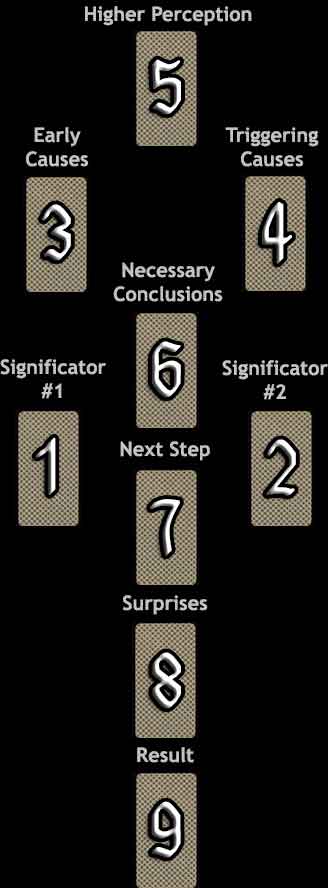
Difficulty: Kind of tough
The Ankh Spread is for questions about the causes behind trends. It is similar to the Celtic Cross and Secret of the High Priestess spreads, but it covers the reasons behind the circumstances in question differently, perhaps giving a better explanation of why things are the way they are.
The loop of the upper section of the ankh reveals the spiritual background and causes of the situation, while the stem of the base focuses on prospects for the outcome.
The first two tarot cards represent the two parent causes of the situation. They will either complement each other or show two opposing sides of a conflict, depending on how they relate. These are the significator cards of the Ankh spread.
3. This tarot card shines light upon the early causes of the trend in question.
4. Pinpoints the causes that triggered the current situation.
5. Reveals the spiritual perspective of the subject at hand.
6. This card examines the reasons why this course of action had to unfold, as a means to this end.
At this point, it is good to pause to soak in the meaning of the first six cards before moving forward to the last three cards. The last three reveal prospects for the future.
7. The Next Step gives clues about the immediate future.
8. Surprising Experiences encountered en route to the result.
9. This represents the result.
Your Ankh Reading
Higher Perceptions 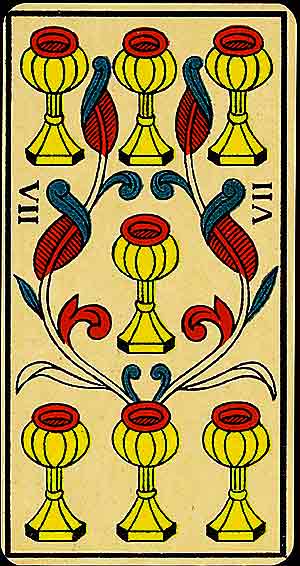 Seven of Cups |
||
Early Causes
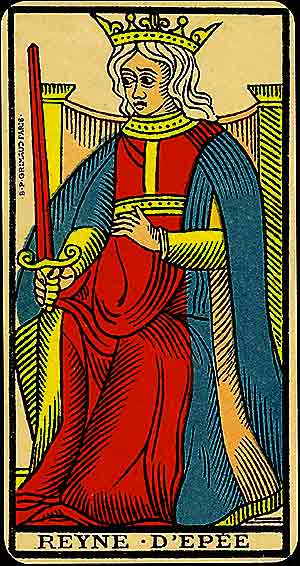 Queen of Swords |
Triggering Causes
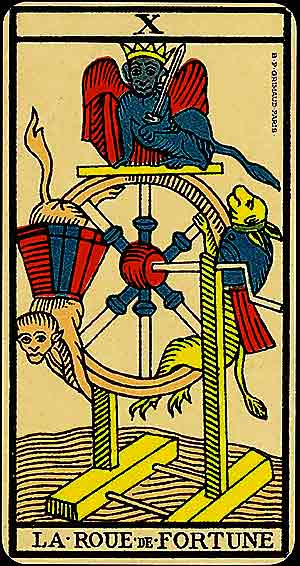 X – The Wheel of Fortune (La Roue de Fortune) |
|
Necessary Conclusions
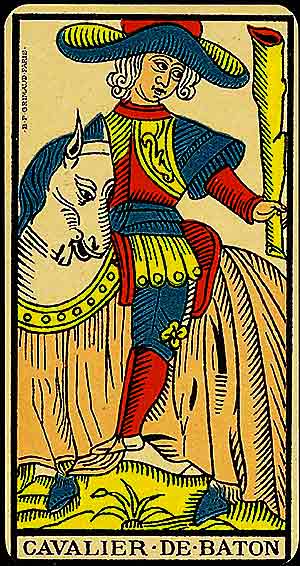 Knight of Batons |
||
Significator #1
 Nine of Cups |
Significator #2
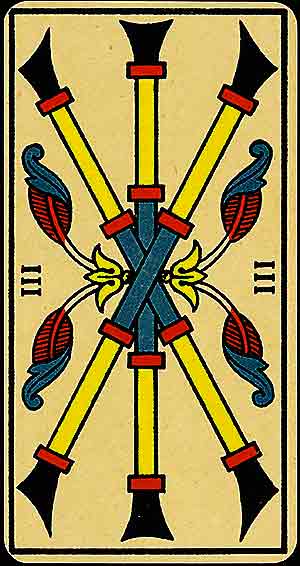 Three of Batons |
|
Next Step
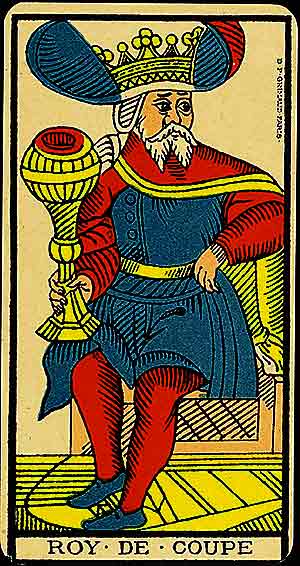 King of Cups |
||
Surprising Experiences 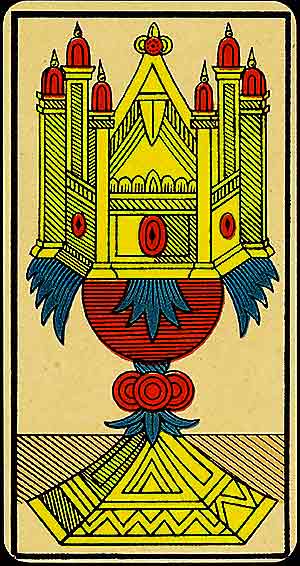 Ace of Cups |
||
Outcome 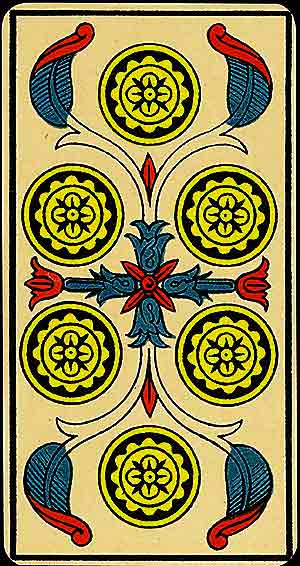 Six of Coins |

Significator #1
Nine of Cups
The Nine of Cups is a card of contentment, fulfilment, and the realisation of emotional desires. It is sometimes referred to as the 'wish card', symbolising the joy of achievement.
Symbolism: Nine cups are arranged in a symmetrical, flowing pattern, with flourishing decorations that reflect abundance and satisfaction. The balanced structure suggests harmony and emotional success.
In Relationships: Emotional satisfaction and a harmonious relationship. It may signify a wish fulfilled in love.
In Work: Recognition and rewards for hard work. Enjoy the fruits of your labour and celebrate your achievements.
Spiritually: The card reflects gratitude and alignment with your inner truth, inviting you to celebrate your blessings.
When ill-dignified: Complacency, overindulgence, or self-centredness. It warns against taking emotional fulfilment for granted.

Significator #2
Three of Batons
The Three of Batons signifies expansion and the realisation of early progress. It is a card of growth through exploration and the courage to venture into new realms.
Symbolism: Three batons interlace harmoniously, with flourishing leaves that reflect growth. The triangular crossing suggests stability in motion, as progress unfolds from a solid foundation.
In Relationships: Relationships flourish through shared aspirations and mutual support. It may indicate exploring new horizons together.
In Work: Initial successes lead to broader opportunities. This card encourages continued effort and long-term vision.
Spiritually: A reminder to expand your perspective and trust the journey towards greater understanding.
When ill-dignified: Frustration or delays in progress. It warns against complacency or overconfidence.

Early Causes
Queen of Swords
The Queen of Swords represents wisdom, clarity, and the ability to make balanced decisions through intellect and discernment. She encourages a blend of compassion and reason when approaching challenges.
Symbolism: Seated with poise on her throne, the Queen holds her sword upright, a symbol of her unwavering commitment to truth and fairness. Her serene expression and elevated position suggest clarity of thought and emotional maturity.
In Relationships: This card reflects fairness, honesty, and emotional clarity. It highlights the importance of setting boundaries and maintaining open, respectful dialogue.
In Work: The Queen advises making thoughtful, well-informed decisions. She represents the ability to lead with integrity and insight, even in challenging situations.
Spiritually: The Queen symbolises the wisdom gained from life's trials and the mastery of using intellect to navigate emotional and spiritual truths.
When ill-dignified: Coldness, rigidity, or harsh judgements. It warns against being detached or being a jerk in your interactions.

Triggering Causes
X – The Wheel of Fortune (La Roue de Fortune)
The Wheel of Fortune symbolises the ever-turning cycles of life, fate, and destiny. It teaches the importance of adaptability and trust in the rhythms of change.
Symbolism: The wheel is adorned with figures ascending and descending, representing the rise and fall of fortunes. Its circular motion evokes the cyclical nature of existence, while divine forces implied by the card's design suggest that some aspects of life are beyond human control.
In Relationships: Changes in relationship dynamics or the appearance of new opportunities. Trust in the flow of events.
In Work: A shift in circumstances, often bringing unexpected opportunities. Stay flexible and open to change.
Spiritually: The Wheel of Fortune reflects the interconnectedness of life's cycles, encouraging surrender to the divine plan.
When ill-dignified: Resistance to change or clinging to outdated patterns. It warns of losing perspective during times of transition.

Higher Perceptions
Seven of Cups
The Seven of Cups represents imagination, choice, and the allure of possibilities. It warns of illusion and the importance of discernment when faced with multiple options.
Symbolism: Seven cups form an intricate pattern, their arrangement suggesting complexity and the uncertainty of choices. The floral embellishments evoke imagination and the pull of dreams, both promising and deceptive.
In Relationships: Idealisation of a partner or confusion about what you desire.
In Work: Opportunities arise, but careful evaluation is needed to separate genuine prospects from illusions.
Spiritually: The card reflects the richness of the inner world but calls for grounding and clarity in spiritual pursuits.
When ill-dignified: Overwhelm, fantasy, or escapism. It warns against being paralysed by options or losing touch with reality.

Necessary Conclusions
Knight of Batons
The Knight of Batons embodies bold action, passion, and the determination to pursue dreams with unyielding energy. This card encourages moving forward fearlessly but with mindful direction.
Symbolism: Riding a powerful horse, the Knight turns to the left, his baton raised, representing ambition and drive. The landscape is dynamic, reflecting the urgency and intensity of his mission.
In Relationships: The card suggests fiery passion, exciting pursuits, or adventurous connections. It calls for embracing the thrill of love while balancing impulsive tendencies.
In Work: It symbolises bold moves, taking calculated risks, or pursuing a goal with tenacity. The Knight encourages decisive action and warns against hesitation.
Spiritually: The Knight represents momentum and the courage to take steps towards spiritual growth or creative expression. It urges you to trust your inner fire to guide you.
When ill-dignified: Recklessness, impatience, or arrogance. It warns against rushing into situations without preparation or foresight.

The Next Step
King of Cups
The King of Cups represents emotional balance, wisdom, and leadership. He embodies the ability to guide others with kindness and understanding while maintaining his own emotional stability.
Symbolism: Seated on his throne with a serene expression, the King holds a cup, symbolising emotional authority. The structure around him reflects his connection to intuition and emotional balance.
In Relationships: This card signifies a stable and emotionally mature partner or dynamic. It encourages fostering relationships built on mutual respect, trust, and emotional stability.
In Work: The King highlights leadership through emotional intelligence and wisdom. It suggests guiding others with compassion and remaining calm in challenging situations.
Spiritually: The King represents the harmony between intellect and emotions, urging you to channel your emotional stability into guiding yourself and others with integrity.
When ill-dignified: Emotional suppression, volatility, or manipulation. It warns against using emotional influence for selfish gain or allowing inner turbulence to disrupt your leadership.

Surprises
Ace of Cups
The Ace of Cups embodies the pure essence of emotional fulfilment, love, and spiritual connection. It represents the beginning of a satisfying phase in relationships, creativity, or inner growth.
Symbolism: A single chalice sits at the centre, decorated with royal motifs. The flowing embellishments signify abundance, renewal, and the divine source of emotional nourishment. The symmetry emphasises harmony and the wholeness of new beginnings.
In Relationships: The Ace heralds the start of a new relationship or the rekindling of emotional intimacy. It speaks of deep emotional connections.
In Work: A surge of inspiration or the beginning of a project that aligns with your heart's desires.
Spiritually: The card represents a divine outpouring of love and spiritual awakening, calling the seeker to open their heart to the infinite.
When ill-dignified: Emotional blocks, insincerity, or missed opportunities for connection. It warns against repressing feelings or ignoring the heart's call.

The Outcome
Six of Coins
The Six of Coins represents generosity, balance, and the cycle of giving and receiving. It signifies harmony in material matters and the importance of equitable exchange.
Symbolism: Six coins are arranged in a pair of triangles, accompanied by floral motifs that reflect abundance and fairness. The design conveys balance and the flow of resources.
In Relationships: Mutual generosity and support strengthen relationships. It emphasises fairness and balance in emotional give-and-take.
In Work: A time of financial balance or assistance, where efforts are rewarded, or you are in a position to help others.
Spiritually: The card reflects the value of sharing knowledge or resources, reminding the seeker of the abundance that flows from generosity.
When ill-dignified: Inequity, selfishness, or imbalance in giving and receiving. It warns against exploiting generosity or neglecting fairness.